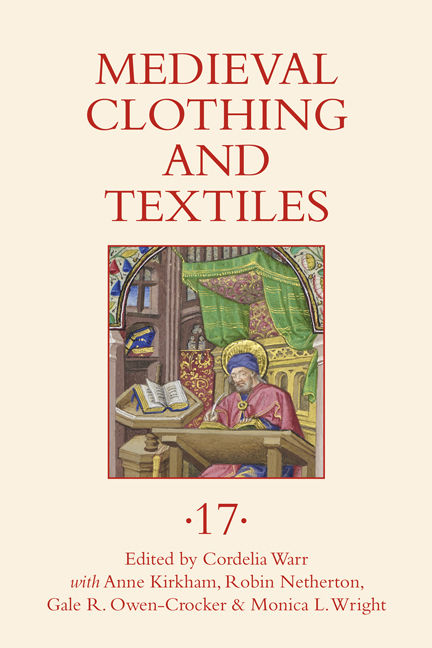Book contents
- Frontmatter
- Contents
- Illustrations
- Tables
- Contributors
- Acknowledgements
- Preface
- 1 Embroidered Beasts: Animals in the Bayeux Tapestry
- 2 The Sleeve from Bussy-Saint-Martin: A Rare Example of Medieval Quilted Armor
- 3 The Administration of Cloth and Clothing in the Great Wardrobe of Edward I
- 4 Hanging Together: Furnishing Textiles in a Fifteenth-Century Book of Hours
- 5 Gilt-leather Embroideries from Medieval Sweden and Finland
- 6 From Hennin to Hood: An Analysis of the Evolution of the English Hood Compared to the Evolution of the French Hood
- Recent Books of Interest
- Author Index, Volumes 1–16
1 - Embroidered Beasts: Animals in the Bayeux Tapestry
Published online by Cambridge University Press: 17 December 2023
- Frontmatter
- Contents
- Illustrations
- Tables
- Contributors
- Acknowledgements
- Preface
- 1 Embroidered Beasts: Animals in the Bayeux Tapestry
- 2 The Sleeve from Bussy-Saint-Martin: A Rare Example of Medieval Quilted Armor
- 3 The Administration of Cloth and Clothing in the Great Wardrobe of Edward I
- 4 Hanging Together: Furnishing Textiles in a Fifteenth-Century Book of Hours
- 5 Gilt-leather Embroideries from Medieval Sweden and Finland
- 6 From Hennin to Hood: An Analysis of the Evolution of the English Hood Compared to the Evolution of the French Hood
- Recent Books of Interest
- Author Index, Volumes 1–16
Summary
The Bayeux Tapestry is an eleventh-century embroidery over 68 metres long and about 50 centimetres wide, depicting, in the form of a continuous graphic narrative with succinct, Latin captions, (alleged) events prior to the Norman Conquest of England. The chief protagonist is the English earl, Harold Godwinsson, brother-in-law of King Edward the Confessor. Harold is portrayed as pious and heroic, but is trapped into swearing an oath to William, Duke of Normandy. He reneges on his oath to take the throne of England (as Harold II) on the death of the childless Edward, but loses it to William, dying at the Battle of Hastings. The Tapestry exhibits the viewpoint of the Norman conquerors, relating that Harold, intending perhaps to visit Normandy (not mentioned in English sources), was captured by Guy of Ponthieu and taken from Guy by William; and that Harold was a perjurer, justifiably replaced by William, the rightful heir; but sometimes it seems sympathetic to the English or appears to exhibit wry wit at the expense of both sides.
It is acknowledged to be of English design, almost certainly conceived in Canterbury since there is widespread use of images from Canterbury manuscripts as models for scenes in the Tapestry. It was made after the Battle of Hastings of October 1066, which it depicts, and probably before the disgracing of Odo, half-brother of William the Conqueror, who features in it in a favourable light: Odo was imprisoned in 1082 and banished from England in 1088.
The Tapestry portrays 762 animals (not counting decorative animal heads on ships, buildings, and furniture), including domestic/tamed/farm animals (horse, dog, hawk, pig, sheep, ox, donkey/ass, pack pony, hen/cock, goose, goat); wild animals, to some degree familiar to the artists and original audience of the Tapestry (boar, crane/heron, dove, fox, peacock, hare, frog, deer, bear, fish); foreign, exotic animals known to the artists from images and stories (lion, camel, possible ostrich); and fantasy creatures of similar artistic or literary origins (winged lion, winged horse, dragon, amphisboena, senmurv, centaur, homodubius).
Animals occur in the central register of the frieze as accessories in the narrative of human ambition and rivalry related there; and in the top and bottom borders, where the default filling is a regular alternation of paired creatures.
- Type
- Chapter
- Information
- Medieval Clothing and Textiles , pp. 1 - 27Publisher: Boydell & BrewerPrint publication year: 2023

